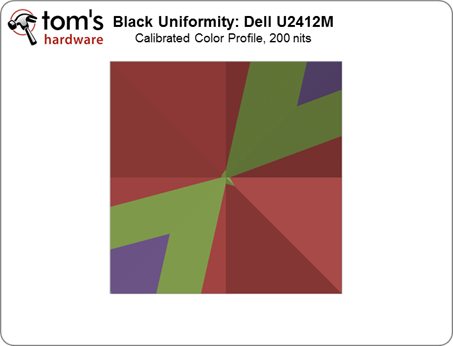24" LCD Round-Up: Acer S242HL, Dell U2412M, And Samsung T24A550
Black And White Uniformity, Viewing Angles
Another measurable quality of panel performance is brightness uniformity. Most manufacturers calibrate displays based on the center point of the screen. However, every area of the screen behaves differently. Sometimes you can get better performance in one specific region. As a result, we add a nine-point black and white luminance test to measure the performance of each monitor's panel.
| Acer S242HL bid | ||
|---|---|---|
| White Luminance cd/m^2 | ||
| 168.0450 | 194.6798 | 186.0228 |
| 166.9632 | 192.4567 | 173.1384 |
| 181.5509 | 193.0398 | 193.6341 |
| Black Luminance cd/m^2 | ||
| 0.8134 | 1.0060 | 1.0290 |
| 0.8704 | 1.0659 | 1.0368 |
| 1.0407 | 1.0753 | 1.0571 |
The S242HL bid suffers from poor backlight uniformity. For whites, we achieve ~190 cd/m2 towards the center of the screen. But as we move further away, luminosity falls off, causing a banding effect. The upper left-hand corner produces a slightly deeper black, which throws off black uniformity to a small degree.
| Dell UltraSharp U2412M | ||
|---|---|---|
| White Luminance cd/m^2 | ||
| 159.7259 | 177.4599 | 162.5423 |
| 165.5319 | 202.4358 | 172.7532 |
| 168.5267 | 175.4136 | 173.3799 |
| Black Luminance cd/m^2 | ||
| 0.1023 | 0.1566 | 0.3612 |
| 0.1309 | 0.2031 | 0.1105 |
| 0.4035 | 0.1442 | 0.1619 |
Black luminance is scattered on the U2412M, though the problem is barely noticeable thanks to deep black production. In our opinion, white luminance is more of an issue. Dead center, we're able to achieve 200 cd/m2, but luminance falls off as we move our spectrophotometer further away.
| Samsung SyncMaster T24A550/T24A350 | ||
|---|---|---|
| White Luminance cd/m^2 | ||
| 124.7582 | 146.5855 | 129.2932 |
| 130.5615 | 154.1653 | 126.5797 |
| 135.0890 | 149.5426 | 140.1892 |
| Black Luminance cd/m^2 | ||
| 0.2914 | 0.4161 | 0.2766 |
| 0.3429 | 0.3440 | 0.3071 |
| 0.3331 | 0.2439 | 0.2943 |
As we already mentioned, we had to settle for a lower 150 cd/m2 calibration on the T24A550 because the panel's backlight isn't of sufficient quality to hit 200 cd/m2.
At this lower calibration setting, Samsung offers up decent white uniformity, but we still see very strong luminance towards the center of the screen. Viewing a pure white background or an image with a bright color palate, the problem is quite evident.
Black uniformity is a bit more mixed. There's a strong tendency towards deep black production near the bottom edge of the screen, which skews perception to a small degree.
Get Tom's Hardware's best news and in-depth reviews, straight to your inbox.
Current page: Black And White Uniformity, Viewing Angles
Prev Page Calibrated Performance: Color Accuracy And Gamut Next Page Power Consumption




